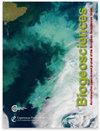Low cobalt inventories in the Amundsen and Ross seas driven by high demand for labile cobalt uptake among native phytoplankton communities
IF 3.9
2区 地球科学
Q1 ECOLOGY
引用次数: 1
Abstract
Abstract. Cobalt (Co) is a scarce but essential micronutrient for marine plankton in the Southern Ocean and coastal Antarctic seas, where dissolved cobalt (dCo) concentrations can be extremely low. This study presents total dCo and labile dCo distributions measured via shipboard voltammetry in the Amundsen Sea, the Ross Sea and Terra Nova Bay during the CICLOPS (Cobalamin and Iron Co-Limitation of Phytoplankton Species) expedition. A significantly smaller dCo inventory was observed during the 2017/2018 CICLOPS expedition compared to two 2005/2006 expeditions to the Ross Sea conducted over a decade earlier. The dCo inventory loss (∼ 10–20 pM) was present in both the surface and deep ocean and was attributed to the loss of labile dCo, resulting in the near-complete complexation of dCo by strong ligands in the photic zone. A changing dCo inventory in Antarctic coastal seas could be driven by the alleviation of iron (Fe) limitation in coastal areas, where the flux of Fe-rich sediments from melting ice shelves and deep sediment resuspension may have shifted the region towards vitamin B12 and/or zinc (Zn) limitation, both of which are likely to increase the demand for Co among marine plankton. High demand for Zn by phytoplankton can result in increased Co and cadmium (Cd) uptake because these metals often share the same metal uptake transporters. This study compared the magnitudes and ratios of Zn, Cd and Co uptake (ρ) across upper-ocean profiles and the observed order-of-magnitude uptake trends (ρZn > ρCd > ρCo) that paralleled the trace metal concentrations in seawater. High rates of Co and Zn uptake were observed throughout the region, and the speciation of available Co and Zn appeared to influence trends in dissolved metal : phosphate stoichiometry and uptake rates over depth. Multi-year loss of the dCo inventory throughout the water column may be explained by an increase in Co uptake into particulate organic matter and subsequently an increased flux of Co into sediments via sinking and burial. This perturbation of the Southern Ocean Co biogeochemical cycle could signal changes in the nutrient limitation regimes, phytoplankton bloom composition and carbon sequestration sink of the Southern Ocean.阿蒙森海和罗斯海的钴库存较低,这是由于本地浮游植物群落对钴的不稳定吸收需求高所致
摘要钴(Co)是南大洋和南极沿海海洋浮游生物的一种稀缺但必需的微量营养素,在这些海域,溶解的钴(dCo)浓度可能极低。本研究介绍了在CICLOPS (Cobalamin and Iron Co-Limitation of Phytoplankton Species)考察期间,通过船载伏安法在阿蒙森海、罗斯海和特拉诺瓦湾测量的总dCo和不稳定dCo分布。与十多年前在2005/2006年对罗斯海进行的两次考察相比,2017/2018年CICLOPS考察期间观察到的dCo库存明显减少。dCo库存损失(~ 10-20 pM)存在于表层和深海中,这是由于不稳定dCo的损失,导致dCo在光区被强配体几乎完全络合。南极沿海海域dCo存量的变化可能受到沿海地区铁(Fe)限制缓解的驱动,在沿海地区,来自融化冰架的富铁沉积物通量和深层沉积物再悬浮可能使该地区转向维生素B12和/或锌(Zn)限制,这两者都可能增加海洋浮游生物对Co的需求。浮游植物对锌的大量需求可导致Co和镉(Cd)的吸收增加,因为这些金属通常共享相同的金属吸收转运体。本研究比较了各大洋上层剖面中Zn、Cd和Co的吸收量(ρ)和比值,以及观测到的吸收量趋势(ρZn >ρCd比;ρCo),与海水中微量金属浓度平行。整个地区都观察到Co和Zn的高吸收率,有效Co和Zn的形态似乎影响溶解金属:磷酸盐化学计量和深度吸收率的趋势。多年来整个水柱中dCo存量的损失可能是由于颗粒有机物中Co吸收的增加以及随后通过下沉和掩埋进入沉积物的Co通量的增加。南大洋Co生物地球化学循环的这种扰动可能预示着南大洋营养限制机制、浮游植物华度组成和碳汇的变化。
本文章由计算机程序翻译,如有差异,请以英文原文为准。
求助全文
约1分钟内获得全文
求助全文
来源期刊

Biogeosciences
环境科学-地球科学综合
CiteScore
8.60
自引率
8.20%
发文量
258
审稿时长
4.2 months
期刊介绍:
Biogeosciences (BG) is an international scientific journal dedicated to the publication and discussion of research articles, short communications and review papers on all aspects of the interactions between the biological, chemical and physical processes in terrestrial or extraterrestrial life with the geosphere, hydrosphere and atmosphere. The objective of the journal is to cut across the boundaries of established sciences and achieve an interdisciplinary view of these interactions. Experimental, conceptual and modelling approaches are welcome.
 求助内容:
求助内容: 应助结果提醒方式:
应助结果提醒方式:


